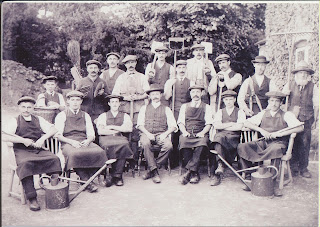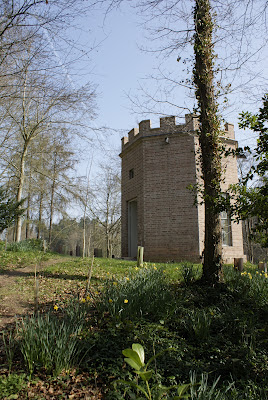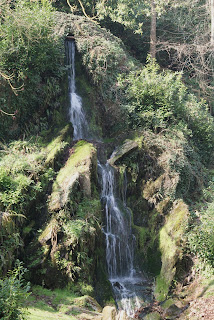It's been a handful of years since I last visited Hestercombe gardens, and it was great to revisit last weekend to see how the garden is progressing. I last time I visited was in 2008 with my family, and it poured with rain, yet this time couldn't have been more different. The sun shone bright across the Vale of Taunton and we were nice and early, ensuring plenty of time for a good stroll around the landscape garden before lunch, followed by the formal gardens in the afternoon.
 |
| Hestercombe, Gary Webb |
Around the time of my last visit, I'd been living less than a mile away
and knew the gardens very well. I'd been there for training courses, talks, meetings with the gardeners and on one occasion was invited to a 'gardeners' lunch put on for some of the regions gardeners. I tried very hard not to drop crumbs whilst sat next to Jekka McVickar for lunch... My memory of a tour by the then head gardener, Micky Little will stay with me for some while. An inspirational and unique gardener who certainly passed on his infectious enthusiasm for Hestercombe. I was hooked on the gardens from my first visit, there isn't anywhere else quite like it, and 'Paradise Restored' as they used to say is a perfect description.
and knew the gardens very well. I'd been there for training courses, talks, meetings with the gardeners and on one occasion was invited to a 'gardeners' lunch put on for some of the regions gardeners. I tried very hard not to drop crumbs whilst sat next to Jekka McVickar for lunch... My memory of a tour by the then head gardener, Micky Little will stay with me for some while. An inspirational and unique gardener who certainly passed on his infectious enthusiasm for Hestercombe. I was hooked on the gardens from my first visit, there isn't anywhere else quite like it, and 'Paradise Restored' as they used to say is a perfect description.
Two of the key elements, the landscape garden and the formal Jekyll/Lutyens garden are elements that combine beautifully, and whilst they're from very different time periods, they mesh well together yet retain individuality - all through the clever use of garden design. To think of garden design being this advanced at such an early stage is inspiring, and it was carried out here to such great effect. Both of the above mentioned areas include a tapestry of designed views, both inwardly to other areas of the garden, or externally to Taunton and Somerset. A complex scheme indeed, and deservedly so for the easiest option would have been to open up the view entirely, making more use of the open countryside; the danger of course is that the panorama might have out shone the garden. Indeed, how many times have you stopped to soak up a panoramic view and thought 'look at that, how can you compete with that?!' Well, the Bampfyldes did take on that panoramic view in the 18th Century, along with Sir Edwin Lutyens and Gertrude Jekyll in the early 20th Century; and they very much succeeded.
 |
| This garden made me smile - it must be good! Photo by Rebecca Webb. |
The trees were mostly still in bud for our visit and I expected the landscape garden to be that little bit easier to read. What I hadn't expected however was a completely restored Octagon Summerhouse, and the stunning views it now offered over the Pear Lake - this garden building is now fully restored and open to visitors. A beautifully placed structure and refreshingly new looking, it sits proudly on a promontory and takes full advantage of the views from two large Georgian picture windows. I remember on an earlier visit that this location was a hot spot of garden archaeology, and where the foundations were located and exposed. The information gathered back then helped to determine the size and scale of the building and it is a credit to all who were involved in the rebirth of this Phoenix like summerhouse. I must say, it is similar in plan to the equally pretty summerhouse on the keep at Dunster Castle, and to my Rebecca, it appeared as a princess castle. We loved it!
I could very easily keep typing about our trip around Hestercombe that day, for even as I know the garden well, it still held lovely surprises and delightful moments. Even the wedding guests arriving for an Orangery based service somehow added to our visit. As a practical gardener and someone interested in history particularly, I like to compare and contrast the garden management, and try to understand how a garden would have looked in its prime, and compare to the here and now. I look closely to see how a shrubbery is manicured, how the sward is managed, and how well the trees are pruned for example.
Naturally, I consider the modern pressures on running a public garden! Considering my fascination with historic gardening and techniques, I spotted a postcard in the gardens shop, a photograph of a team of Hestercombe gardeners from around 1912, all smartly dressed with their flat caps and chosen tool of the day. Pride seems to radiate from those gardeners, and I'm sure they would be proud to have seen the achievements over the last few years. Philip White, the chief executive has shown a great deal of tenacity in leading the restoration of Hestercombe, and the staff we encountered showed a pride in their work equal to that apparent in the gardeners postcard. It is great to see the gardens flourishing and providing a living for a new generation of people. After all, somebody now, just as back then, has to grow and raise the plants, somebody has to manage the grass sward (without a scythe I hasten to add,) and somebody has to nurture those 'Jekyll' borders.
Naturally, I consider the modern pressures on running a public garden! Considering my fascination with historic gardening and techniques, I spotted a postcard in the gardens shop, a photograph of a team of Hestercombe gardeners from around 1912, all smartly dressed with their flat caps and chosen tool of the day. Pride seems to radiate from those gardeners, and I'm sure they would be proud to have seen the achievements over the last few years. Philip White, the chief executive has shown a great deal of tenacity in leading the restoration of Hestercombe, and the staff we encountered showed a pride in their work equal to that apparent in the gardeners postcard. It is great to see the gardens flourishing and providing a living for a new generation of people. After all, somebody now, just as back then, has to grow and raise the plants, somebody has to manage the grass sward (without a scythe I hasten to add,) and somebody has to nurture those 'Jekyll' borders.
 |
| Hestercombe Gardeners, circa 1912. Copyright Hestercombe Gardens. |
Maybe I should stop guilding the lily, but I'd say on the whole that Hestercombe has an appeal to many, not just garden followers, and if you find yourself in the region it is well worth a visit. There are plenty of well established events throughout the year, a quality cafe and restaurant, and a well stocked garden shop and plant centre. Do have a look at their website for details, and as if you need any more convincing to visit, they've even won a gold in 2012/11 for excellence in tourism. What more can I say!
Links:
Many thanks to Hestercombe Gardens for use of the gardeners image.



4 comments:
This post gives rise to the disconcerting thought - if the scenery is brilliant, why have a garden at all beyond the practical bits to walk and sit in?
I imagine it would be good to have a gardening staff as large as the big houses used to have?
Many thanks for the comments, a couple of weighty points to respond to potentially!
I’d say the reason for the landscape garden seems to have been in the pursuit of art, atmosphere and experience, as well as to display wealth and intellect. I remember that one of the Bampfylde’s responsible for the garden was a keen artist, and many landscape gardens as I’m sure you’re aware, are inspired from art or created to imitate mythical and naturalistic art masterpieces, those of Claude Lorraine spring to mind.
This garden offered a carefully planned route, which allowed visitors to enjoy a journey to a range of very different garden buildings, each in their own setting. From certain positions, looking within the garden, those buildings can be seen as a collection, and to this end did try to imitate art as mentioned above.
The garden as a whole, although designed with art in mind, was also constructed to be used physically. Whilst the distant views were controlled and framed nicely with trees, the ‘inner’ garden was engineered for various uses: places where business deals could be struck; banquets could be consumed; quiet solace taken, and private family fun enjoyed. Furthermore, fish could be farmed in quantity and the latest botanical introductions could be exhibited and studied. Beautiful, clever in its design and very practical - for a wealthy landowner at least!
Regarding teams of gardeners, we’re lucky to have some very good labour saving machinery around these days, it may not be as green as the old manual methods, but it is very effective. I guess overheads for garden staff in Olde England were much less then too!
Anybody have any further thoughts in addition to mine and Lucy’s?
It's a challenging (and daunting!) thought - the idea of gardening to create a work of art. Quite a tough concept when one might be dead before it comes to maturity and the people in between might have ideas which will mess up what one envisaged. It's only in very recent years I've thought how it might be nice to be so mega rich one could own a big garden and have enough money left over to import ready-grown trees and plants and treat the landscape like a canvas. The idea, though, of dividing a garden into areas with different functions (rather like rooms) is one which can be put into practice on even the miniest of scales, even if it's just "this window sill is for micro-salads and this is for flowers"! It can expand the imagination as well as still the mind.
Re. gardening staff in 'the old days', have you read 'Old Herbaceous' by Reginald Arkell? It's a delight.
No, I haven't read Old Herbaceous, but will keep an eye out for that one.
Gardening can be a long drawn out affair indeed. I've got used to planting trees knowing other generations will enjoy them. Also, have worked hard to pull some gardens back from a wilderness, knowing they were once well loved and were left to grow wild, and also knowing that they may in future be left to grow wild once again. I think they are fantastic in all their forms, and offer so much. You touched on the window sill; and my nephew recently proudly showed off his eco garden, all enclosed in a mini glass house on his window sill - I was impressed at how engaged he was at such a young age. Very warming and cheap to do too - loved it!
Post a Comment